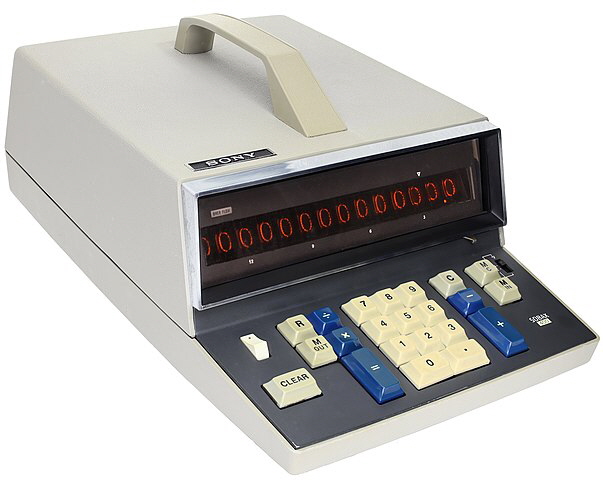Sony
Sony, Japan.
Sony manufactured and marketed a range of high-quality desktop calculators from the mid- 1960s to the early 1970s. Many could be fitted with an optional adapter for operation from a rechargeable battery pack or car battery and so were fitted with a carrying handle to make them portable.
Example of a Sony calculator

Sony SOBAX 400W
A desktop model with a 14-digit 'Nixie'-type display dating from about 1969.
This is a featured calculator.
Image by 'Mr rf' [CC BY-SA 4.0 (https://creativecommons.org/licenses/by-sa/4.0/], via Wikimedia Commons
The journal 'Electronics' described Sony's entry into the electronic calculator market in 1967[1]:
"Calculated entry
The latest entry in Japan's calculator sweepstakes is the Sony Corp., which will be off and running on June 1 with an electronic desk model that uses hybrid integrated circuits and has two memories.
Called the Sobax, for solid state abacus, the unit will be priced at $722. Plans call for a 500-unit monthly production quota initially, with sales limited to Japan.
A first.
Although its price is slightly higher than the lowest-priced Japanese calculators now available, Sony's entry seems to be competitive. It is a 14-digit calculator where most of the others have 12 digits and lack a
memory feature. The new unit operates from low-voltage d-c power supplies and is the first made in Japan that blanks out all zeros before the first significant digit.
Sobax uses a single ultrasonic delay
line—invented by the university of Osaka's Zenichi Kitamura—for five registers, and is believed to be the first to incorporate this feature. Three of the registers are used for arithmetic and the other two operate
as memories.
The delay line performs the functions of five registers on a time-division basis. In the multiplexing scheme, the registers are numbered one through five. The first bit for each
register is inserted into the delay line in sequence; then the second bit of each, and so on. Coiled in a metal box and housed at the base of the calculator, the 3-meter-long delay line has a capacity of 360 bits and a delay
time of 1.5 milliseconds.
Time sharing. The clock frequency is about 40 kilohertz and the time interval of each clock pulse is divided into six
phases—one for each of the five registers and one more for synchronising the delay line.
Although they are now using hybrid IC's, Sony engineers indicate that they may eventually switch to monolithic
circuits. Use of hybrid circuits fits in with Sony's policy, since one reason for marketing this calculator is to make use of the production at Sony's semiconductor plant. Company officials say that purchase of outside
units even at low cost would negate an important reason for building the device.
There are 500 IC's mounted on the calculator's five printed-circuit boards. These circuits have a total of about 8,000
individual components, including 200 transistors and 1,700 diodes. The hybrid circuits are built on alumina substrates and are dip-coated for moisture protection.
Transistors are the only components
within the hybrid circuits that are prepackaged in epoxy. The transistors are the same type used in most of Sony's tape recorders. Diodes and capacitors are attached to the substrate without prior
encapsulation.
There's a difference. Logic circuits consist mainly of diode gates and transistor flip-flops, with a sprinkling of inverters. Among
differences between logic circuits developed by Sony and those that are used by most other firms are the connections between gates and flip-flops. Sony uses capacitor coupling between gates and flip-flops, and d-c coupling of
clocks to flip-flops. Other manufacturers use d-c coupling gates and flip-flops, and capacitor coupling of clock to flip-flops."
In 1973 the journal 'Electronics Today International Australia' announced Sony's exit from the calculator market[2]:
"Sony has decided to
cease production of its SOBAX electronic desk-top calculator, and to fully withdraw from the calculator market by July, 1974. The firm has marketed the calculators since 1964, but has found that the product wasn't returning
sufficient profits.
Production in the electronic calculator market has declined since 1970, with the average unit prices dropping sharply from $597 [Australian $ ?] in 1967 to about $70 in 1973. Total calculator deliveries for Sony amounted to approximately 200,000 units with 1972 sales of $6.49 million, only one percent of their total sales.
The Atsugi plant that produced the calculators will be converted into use for video and audio equipment. Sony plans to sell remaining inventories as they have been sold previously, with the service network taking care of all after-service work, and repair parts will be made available for the next seven years."
The Sony website explains:
"Following the 1967 launch of the first SOBAX model, the ICC-500, the development of compact, low-priced
electronic calculators progressed rapidly. This was due in large part to the development of such semiconductor-based components as ICs, which made electronic circuitry more compact, and LSI (Large-Scale Integrated) circuits, which
were even more compact. Sony and other manufacturers developed LSI circuits based on MOS (Metal-Oxide Semiconductors). However, these proved to be quite expensive for Sony, and the company could not keep pace with the
fierce competition. Sony thus decided to halt production of the SOBAX calculator in 1973. Because of this decision, Sony's digital technology, which had grown as a result of the development of the digital
calculator, was temporarily stalled."
Effectively, Sony had employed hybrid integrated circuit modules, similar to those used in its other products, in its calculators while those circuits were cost-effective. With the development of large-scale silicon integrated circuits for calculators in the early 1970s, heralded by the 'calculator-on-a-chip' devices, the hybrid modules soon became uneconomic in calculators and so Sony withdrew from the calculator industry.
References:
Calculator Companies
Vintage Calculators
Text & photographs copyright, except where stated otherwise, © Nigel Tout 2000-2026.